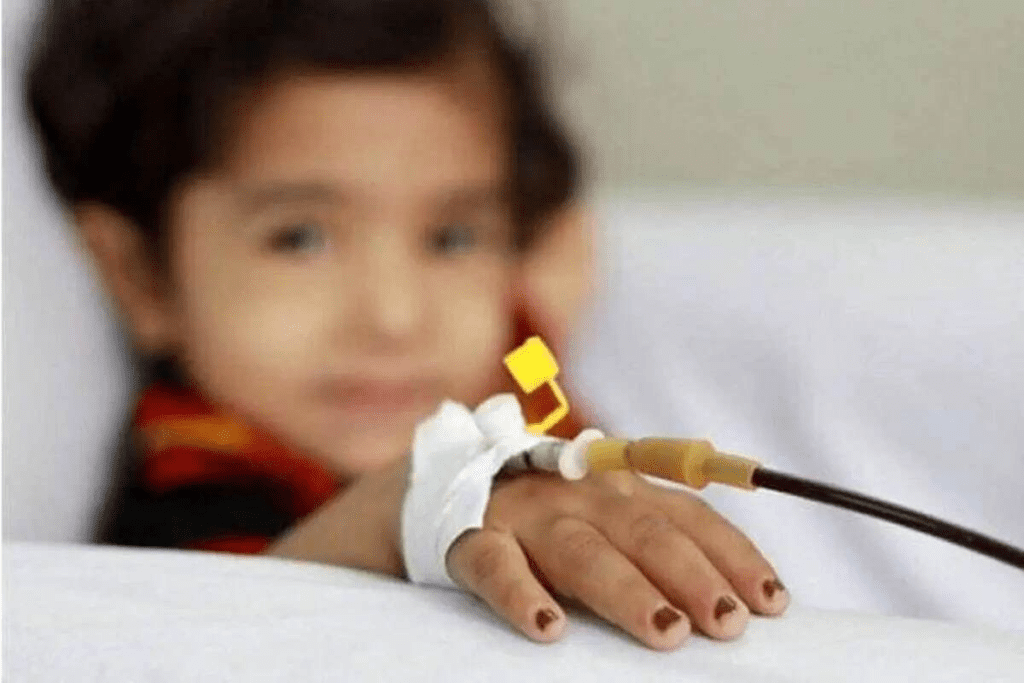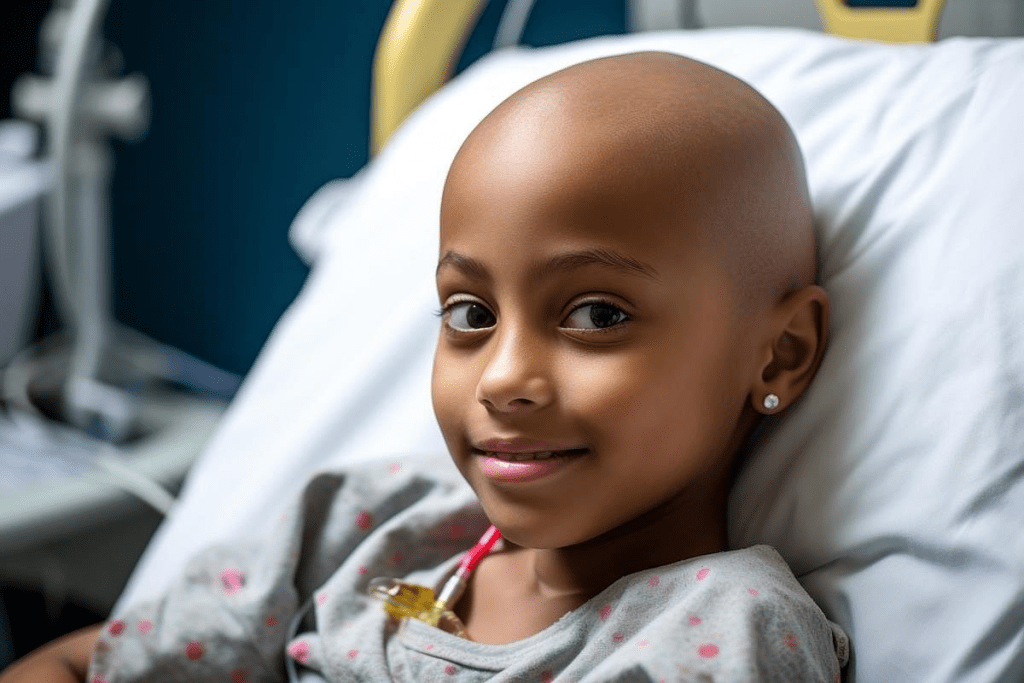Last Updated on November 13, 2025 by
Blood cancer, also known as leukemia, is the most common cancer in kids. It makes up a big part of childhood cancer cases. Spotting the early signs of leukemia symptoms is key to getting help fast.

Every year, about 3,500 to 4,000 kids in the US get diagnosed with leukemia. The symptoms can show up fast, often in days or weeks. Knowing these signs is vital for catching the disease early and treating it effectively.
It’s important to know about blood cancer in kids to catch it early. Childhood blood cancer includes different types, with acute lymphoblastic leukemia (ALL) being the most common.
There are three main types of blood cancer in kids: leukemia, lymphoma, and myeloma. But leukemia symptoms is the most common, with ALL being the most common subtype.
ALL is more common in boys. It’s caused by too many immature white blood cells, which stop normal blood cells from being made.

In the United States, leukemia is a big health issue in kids. ALL makes up about 80% of all childhood leukemia cases.
Knowing these facts and types of blood cancer in kids helps in early detection and treatment. This can greatly improve the outcomes for kids with this disease.
It’s important to know the signs of leukemia in kids to catch it early. The symptoms can look like other common childhood illnesses. So, parents and caregivers need to keep a close eye.
Fatigue is a big sign of leukemia in kids. It means they feel very tired and weak all the time. This can make it hard for them to do everyday things and enjoy life. Fatigue is seen in more than 60% of kids with leukemia.
Other signs related to energy include:
Fever is another common symptom in kids with leukemia. They often get sick. It’s key to watch how often and how long the fever lasts.
Here are some important things to know about fever and infections:

Changes in how much kids eat and their weight are also signs of leukemia. Some kids might eat less and lose weight. Others might eat more and gain weight. It’s important to keep an eye on these changes because they can affect their health.
Signs related to appetite and weight include:
The physical signs of blood cancer in children are key indicators for early diagnosis and treatment. Blood cancer, or leukemia, affects the blood and bone marrow. It’s caused by an abnormal increase in white blood cells. Spotting these signs early is vital for timely medical care.
Easy bruising or bleeding is a common sign of leukemia in kids. This happens because leukemia messes with platelet production. Platelets are key to blood clotting. Kids with leukemia might get frequent nosebleeds, bleeding gums, or easy bruising.
Petechiae, small, dark red spots under the skin, are also a sign. These spots come from minor hemorrhages in broken capillaries.
Anemia is another big sign of leukemia in kids. As leukemia gets worse, it can lower red blood cells, causing anemia. Symptoms include pale skin, fatigue, and shortness of breath.
Children with anemia might look pale or tired. They might not have the energy for their usual activities.
Swelling or enlargement of organs like the liver, spleen, or lymph nodes can point to leukemia. This swelling happens when leukemia cells build up in these organs. Kids with leukemia might feel pain or discomfort in their belly due to an enlarged spleen or liver.
Swollen lymph nodes in the neck, armpits, or groin are also signs. It’s important for parents and caregivers to watch for these signs. If they notice anything unusual, they should get medical help right away. Early detection and treatment can greatly improve a child’s chances of beating leukemia.
Pain is a big problem for kids with leukemia. It shows up in many ways. It’s a key part of their illness and can really hurt their quality. We’ll look at the different kinds of pain kids with leukemia might feel.
Kids with leukemia often have pain in their bones or joints. This happens when leukemia cells build up in these areas, causing swelling and pain. The pain can be so bad that it makes it hard to move around and do everyday things. “Bone pain is a red flag symptom that warrants further investigation,” as it can be an indicator of leukemia progression.
Leukemia can also cause tummy pain or swelling. This happens when leukemia cells gather in the liver or spleen, making these organs bigger. This condition, known as hepatosplenomegaly, can cause tummy pain and discomfort. The pain’s severity can change, depending on how big the organs get.
Kids with leukemia might also feel pain in other ways. For example, headaches can happen because of anemia or bleeding in the brain. It’s very important for caregivers to watch these symptoms closely and get medical help if they don’t get better or get worse.
It’s key to understand and manage pain in kids with leukemia. By spotting these symptoms early, doctors can help improve the child’s life.
It’s important to know the difference between leukemia symptoms and common childhood illnesses. This helps get medical help quickly. Many leukemia symptoms look like those of viral infections, but there are key differences.
Leukemia symptoms can look like the flu or a cold. But there are important differences. For example, leukemia symptoms don’t go away like viral infections do. They often get worse over time.
Leukemia can cause severe symptoms like persistent fatigue, severe bruising, or unexplained bleeding. These are not typical of viral infections.
Parents should worry if their child’s symptoms don’t go away or get worse. For instance, a fever that lasts more than a few days is a red flag. So is persistent bone pain.
Other signs to watch for include unexplained weight loss, swollen lymph nodes, or pale skin. These could mean something serious.
If a child might have leukemia, doctors will run several tests. They’ll do blood tests and bone marrow examinations. These tests check for cancerous cells.
A pediatric oncologist will look at the results and plan treatment. Early detection and treatment are key to managing leukemia.
By knowing the differences between leukemia symptoms and common childhood illnesses, parents can act fast. This is important for their child’s health.
It’s important to know the signs of leukemia in kids to catch it early. If your child is always tired, has bruises, fever, or bone pain, see a doctor. These signs of leukemia mean they might have blood cancer and need help.
We’ve talked about the common symptoms of leukemia in kids. This includes physical signs, pain, and how they differ from usual childhood illnesses. Knowing these symptoms helps parents know when to get medical help. Early treatment is key to better outcomes for kids with leukemia.
If you’re worried about your child’s health or see any signs that last, get them checked by a doctor. They can tell you what to do next and if tests are needed.
Symptoms include feeling very tired, having a fever, and changes in appetite or weight. Other signs are bruising or bleeding easily, pale skin, and swollen organs like the liver or spleen.
Leukemia is a blood cancer that is the most common in kids. It affects the blood and bone marrow. This leads to symptoms that can make daily life hard.
The most common type is acute lymphoblastic leukemia (ALL). Other types include acute myeloid leukemia (AML) and chronic leukemias. But these are less common in kids.
Doctors use a physical exam, blood tests, bone marrow biopsy, and imaging studies. These help find and identify the leukemia type.
The exact cause is often unknown. But genetic mutations, environmental factors, and viral infections may play a role.
Yes, many kids with leukemia can be cured with modern treatments. The chance of cure depends on the leukemia type, treatment response, and other factors.
Early signs include abnormal white blood cell counts, anemia, low platelet counts, or blast cells in the blood.
Yes, tiny red spots, or petechiae, can be a sign of leukemia. They happen due to low platelet counts or bleeding disorders.
Leukemia and its treatment can cause fatigue, pain, and other symptoms. These can affect a child’s daily activities, appetite, and overall well-being.
Parents should worry if symptoms don’t get better, get worse, or if there are other signs. These include significant weight loss, severe pain, or trouble breathing.
Subscribe to our e-newsletter to stay informed about the latest innovations in the world of health and exclusive offers!